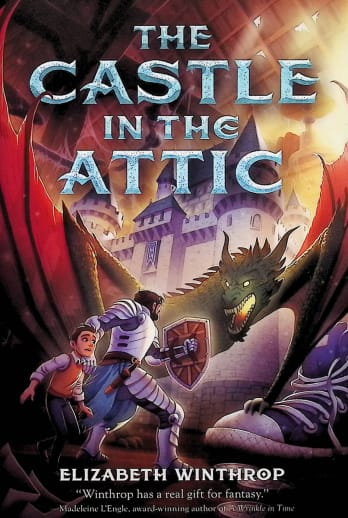Mrs. Phillips has been with William and his family since he was born. Now that he is old enough to take care of himself, the homesick Mrs. Phillips tells William that she will be going back to England to her family. William is sad to see Mrs. Phillips leave but, he is excited about the present she has given him, a model castle complete with drawbridge, moat, courtyard, stable, armory, knight, and more. Along with the castle comes the tale behind it. It is said that the Silver Knight, thrown out of his kingdom by the enemy, is destined to one day come back to life to reclaim his land. When the tiny silver knight comes to life in William's hand, a land of dragons, wizards, and magic is revealed. ~ Enh
Castle in the Attic
Description
Sure enough, when William picks up the tiny silver knight, Sir Simon comes alive in his hand and tells William a mighty story of wild sorcery, wizards, and a kingdom in need of saving. Hoping the castle’s magic holds the key to getting his friend to stay, William embarks on a fantastic quest to another land and another time–where a fiery dragon and an evil wizard are waiting to do battle.
If you're looking for a study guide for a specific book, Novel Units probably has it covered! They produce hundreds of literature guides - only a sampling of them is listed here.
Teacher Guides are 30-40 pages - not voluminous, but enough for good coverage of the book. Format of the guides vary somewhat by grade level, but feature some common elements. They begin with a synopsis of the book and its author, and some pre-reading activities that serve both to provide background for the novel study and initiate student involvement. This segment also gets readers thinking about the story. Chapter by chapter (in some guides, multiple chapters) lesson plans contain vocabulary words, discussion questions (with answers), and suggested activities. Some guides also include writing ideas. Literature concepts/skills appear here and there. Some guides contain reproducible graphic organizers to aid student analysis. All include some culminating questions and activities. Again, these vary in scope and type by guide. There are no objective or essay tests, but each guide ends with a student assessment page that provides a list of projects or exercises to be completed to help evaluate student understanding.
Student Packets, although not available for every book, vary somewhat by grade level and book. Student packets may include: activity pages, study guide, graphic organizers, writing and/or listening and speaking prompts, critical thinking challenges, quizzes and a unit test. Answers are included in the back, along with an essay evaluation form (i.e. rubric). Student packets are not reproducible.
Novel Unit Sets include a Novel Unit study guide and/or teacher guide, as well as the recommended reading book for the guide(s).
Really, each of these components can function as a stand-alone product and can be used without the other, but for a more comprehensive study, they are best used in concert. There is very little overlap between the two, even in the chapter-by-chapter questions - but completing the questions in the student packet will help prepare your child for the more in-depth questions found in the teacher guide. If your child is working independently on a novel, the student packet can be used alone (if available). If you want your student to do little written work and put more emphasis on discussion, the teacher guide can be used by itself.
Please note that some guides have been written to correlate with a specific edition of a book. Some of these editions are now out of print, and we do not carry all versions mentioned. Where multiple editions are available, such as the Adventures of Tom Sawyer, the page numbers given in the guide may not correlate exactly.
| Product Format: | Softcover Book |
|---|---|
| Grades: | 4-6 |
| Brand: | Bantam, Doubleday and Dell |
| Author: | Elizabeth Winthrop |
| ISBN: | 9780440409410 |
| Length in Inches: | 7.5 |
| Width in Inches: | 5 |
| Height in Inches: | 0.5 |
| Weight in Pounds: | 0.3 |
| Ages: | 10 - 13 |
| Edition: | Illustrated |
| Pages: | 192 |
| Publication Date: | 8/1/1986 |

